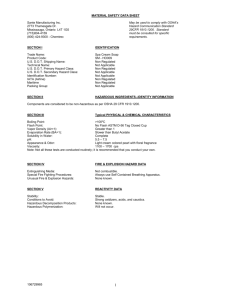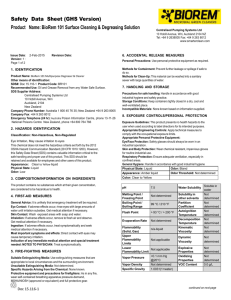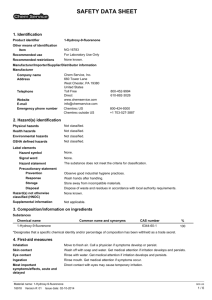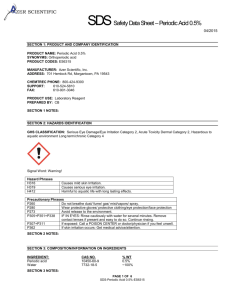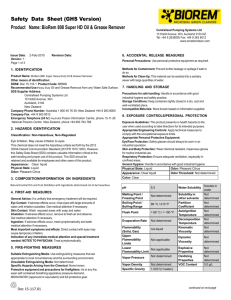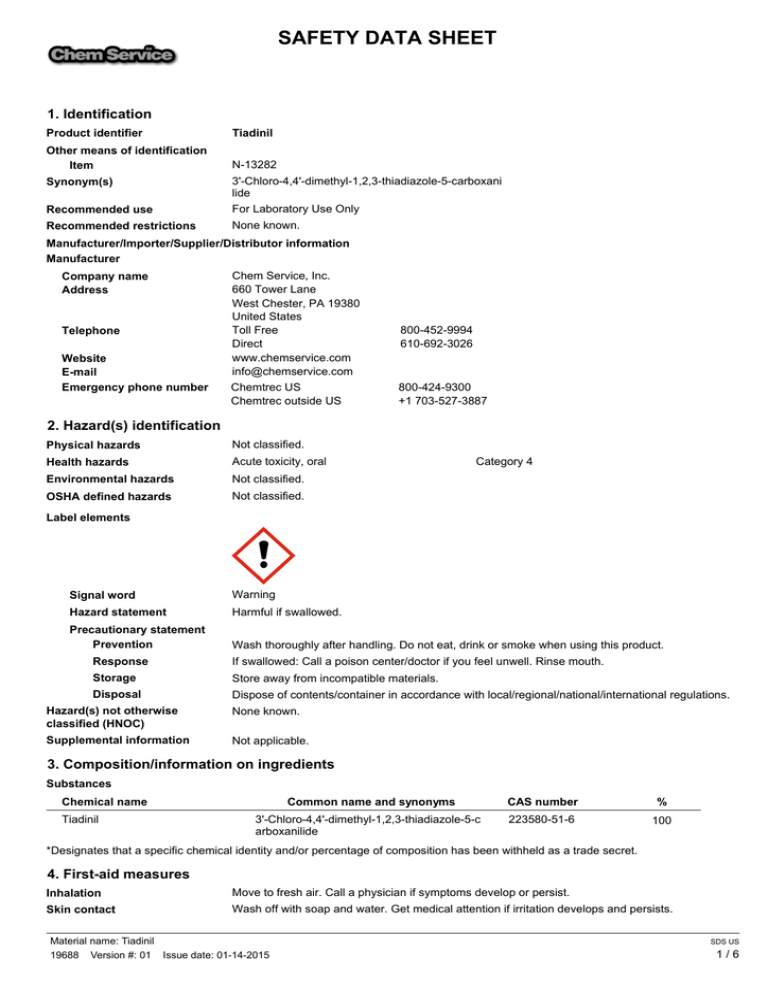
SAFETY DATA SHEET
1. Identification
Product identifier
Tiadinil
Other means of identification
Item
N-13282
Recommended use
3'-Chloro-4,4'-dimethyl-1,2,3-thiadiazole-5-carboxani
lide
For Laboratory Use Only
Recommended restrictions
None known.
Synonym(s)
Manufacturer/Importer/Supplier/Distributor information
Manufacturer
Company name
Address
Telephone
Website
E-mail
Emergency phone number
Chem Service, Inc.
660 Tower Lane
West Chester, PA 19380
United States
Toll Free
Direct
www.chemservice.com
info@chemservice.com
Chemtrec US
Chemtrec outside US
800-452-9994
610-692-3026
800-424-9300
+1 703-527-3887
2. Hazard(s) identification
Physical hazards
Not classified.
Health hazards
Acute toxicity, oral
Environmental hazards
Not classified.
OSHA defined hazards
Not classified.
Category 4
Label elements
Signal word
Warning
Hazard statement
Harmful if swallowed.
Precautionary statement
Prevention
Wash thoroughly after handling. Do not eat, drink or smoke when using this product.
Response
If swallowed: Call a poison center/doctor if you feel unwell. Rinse mouth.
Storage
Store away from incompatible materials.
Disposal
Dispose of contents/container in accordance with local/regional/national/international regulations.
Hazard(s) not otherwise
classified (HNOC)
None known.
Supplemental information
Not applicable.
3. Composition/information on ingredients
Substances
Chemical name
Tiadinil
Common name and synonyms
CAS number
%
3'-Chloro-4,4'-dimethyl-1,2,3-thiadiazole-5-c
arboxanilide
223580-51-6
100
*Designates that a specific chemical identity and/or percentage of composition has been withheld as a trade secret.
4. First-aid measures
Inhalation
Move to fresh air. Call a physician if symptoms develop or persist.
Skin contact
Wash off with soap and water. Get medical attention if irritation develops and persists.
Material name: Tiadinil
19688 Version #: 01 Issue date: 01-14-2015
SDS US
1/6
Eye contact
Rinse with water. Get medical attention if irritation develops and persists.
Ingestion
Rinse mouth. IF SWALLOWED: Call a POISON CENTER or doctor/physician if you feel unwell.
Most important
symptoms/effects, acute and
delayed
Direct contact with eyes may cause temporary irritation.
Indication of immediate
medical attention and special
treatment needed
Provide general supportive measures and treat symptomatically. In case of shortness of breath,
give oxygen. Keep victim warm. Keep victim under observation. Symptoms may be delayed.
General information
In the case of accident or if you feel unwell, seek medical advice immediately (show the label
where possible). Ensure that medical personnel are aware of the material(s) involved, and take
precautions to protect themselves.
5. Fire-fighting measures
Suitable extinguishing media
Water fog. Foam. Dry chemical powder. Carbon dioxide (CO2).
Unsuitable extinguishing
media
Do not use water jet as an extinguisher, as this will spread the fire.
Specific hazards arising from
the chemical
During fire, gases hazardous to health may be formed.
Special protective equipment
and precautions for firefighters
Self-contained breathing apparatus and full protective clothing must be worn in case of fire.
Fire-fighting
equipment/instructions
Use water spray to cool unopened containers.
Specific methods
Use standard firefighting procedures and consider the hazards of other involved materials.
General fire hazards
No unusual fire or explosion hazards noted.
6. Accidental release measures
Methods and materials for
containment and cleaning up
Keep unnecessary personnel away. Keep people away from and upwind of spill/leak. Wear
appropriate personal protective equipment. Ensure adequate ventilation. Local authorities should
be advised if significant spillages cannot be contained. For personal protection, see section 8 of
the SDS.
This product is miscible in water. Stop the flow of material, if this is without risk. Following product
recovery, flush area with water. For waste disposal, see section 13 of the SDS.
Environmental precautions
Avoid discharge into drains, water courses or onto the ground.
Personal precautions,
protective equipment and
emergency procedures
7. Handling and storage
Precautions for safe handling
Conditions for safe storage,
including any incompatibilities
Do not taste or swallow. Provide adequate ventilation. Wear appropriate personal protective
equipment. Observe good industrial hygiene practices. When using, do not eat, drink or smoke.
Wash hands thoroughly after handling.
Store in original tightly closed container. Store away from incompatible materials (see Section 10
of the SDS).
8. Exposure controls/personal protection
Occupational exposure limits
No exposure limits noted for ingredient(s).
Biological limit values
No biological exposure limits noted for the ingredient(s).
Appropriate engineering
controls
Good general ventilation (typically 10 air changes per hour) should be used. Ventilation rates
should be matched to conditions. If applicable, use process enclosures, local exhaust ventilation,
or other engineering controls to maintain airborne levels below recommended exposure limits. If
exposure limits have not been established, maintain airborne levels to an acceptable level.
Individual protection measures, such as personal protective equipment
If contact is likely, safety glasses with side shields are recommended.
Eye/face protection
Skin protection
Hand protection
Other
For prolonged or repeated skin contact use suitable protective gloves.
Wear suitable protective clothing.
Respiratory protection
In case of insufficient ventilation, wear suitable respiratory equipment.
Thermal hazards
Wear appropriate thermal protective clothing, when necessary.
General hygiene
considerations
When using, do not eat, drink or smoke. Always observe good personal hygiene measures, such
as washing after handling the material and before eating, drinking, and/or smoking. Routinely
wash work clothing and protective equipment to remove contaminants.
9. Physical and chemical properties
Appearance
Physical state
Solid.
Material name: Tiadinil
19688 Version #: 01 Issue date: 01-14-2015
SDS US
2/6
Form
Solid.
Color
Not available.
Odor
Not available.
Odor threshold
Not available.
pH
Not available.
Melting point/freezing point
233.96 °F (112.2 °C)
Initial boiling point and boiling
range
Not available.
Flash point
Not available.
Evaporation rate
Not available.
Flammability (solid, gas)
Not available.
Upper/lower flammability or explosive limits
Not available.
Flammability limit - lower
(%)
Flammability limit - upper
(%)
Not available.
Explosive limit - lower (%)
Not available.
Explosive limit - upper (%)
Not available.
Vapor pressure
Not available.
Vapor density
Not available.
Relative density
Not available.
Solubility(ies)
Solubility (water)
13.2 mg/l at 20 °C
Partition coefficient
(n-octanol/water)
Not available.
Auto-ignition temperature
Not available.
Decomposition temperature
Not available.
Viscosity
Not available.
Other information
Density
1.47 at 20 °C
Molecular formula
C11H10ClN3OS
Molecular weight
267.7
10. Stability and reactivity
Reactivity
The product is stable and non-reactive under normal conditions of use, storage and transport.
Chemical stability
Material is stable under normal conditions.
Possibility of hazardous
reactions
No dangerous reaction known under conditions of normal use.
Conditions to avoid
Contact with incompatible materials.
Incompatible materials
Strong oxidizing agents.
Hazardous decomposition
products
No hazardous decomposition products are known.
11. Toxicological information
Information on likely routes of exposure
Harmful if swallowed.
Ingestion
Inhalation
No adverse effects due to inhalation are expected.
Skin contact
No adverse effects due to skin contact are expected.
Eye contact
Direct contact with eyes may cause temporary irritation.
Symptoms related to the
physical, chemical and
toxicological characteristics
Direct contact with eyes may cause temporary irritation.
Information on toxicological effects
Acute toxicity
Harmful if swallowed.
Material name: Tiadinil
19688 Version #: 01 Issue date: 01-14-2015
SDS US
3/6
Product
Species
Test Results
Tiadinil (CAS 223580-51-6)
Dermal
LD50
Rat
> 2000 mg/kg
Inhalation
LC50
Rat
> 2.48 mg/l, 4 hours
Oral
LD50
Rat
> 6147 mg/kg
* Estimates for product may be based on additional component data not shown.
Prolonged skin contact may cause temporary irritation.
Skin corrosion/irritation
Direct contact with eyes may cause temporary irritation.
Serious eye damage/eye
irritation
Respiratory or skin sensitization
Not available.
Respiratory sensitization
This product is not expected to cause skin sensitization.
Skin sensitization
Germ cell mutagenicity
No data available to indicate product or any components present at greater than 0.1% are
mutagenic or genotoxic.
Carcinogenicity
This product is not considered to be a carcinogen by IARC, ACGIH, NTP, or OSHA.
US. OSHA Specifically Regulated Substances (29 CFR 1910.1001-1050)
Not listed.
This product is not expected to cause reproductive or developmental effects.
Reproductive toxicity
Specific target organ toxicity single exposure
Not classified.
Specific target organ toxicity repeated exposure
Not classified.
Aspiration hazard
Not available.
12. Ecological information
Ecotoxicity
The product is not classified as environmentally hazardous. However, this does not exclude the
possibility that large or frequent spills can have a harmful or damaging effect on the environment.
Product
Tiadinil (CAS 223580-51-6)
Crustacea
Other
Species
Test Results
LC50
Daphnia
1.6 mg/l, 48 hours
LC50
Rainbow Trout
3.4 mg/l, 96 hours
* Estimates for product may be based on additional component data not shown.
No data is available on the degradability of this product.
Persistence and degradability
Bioaccumulative potential
No data available.
Mobility in soil
No data available.
Other adverse effects
No other adverse environmental effects (e.g. ozone depletion, photochemical ozone creation
potential, endocrine disruption, global warming potential) are expected from this component.
13. Disposal considerations
Disposal instructions
Local disposal regulations
Hazardous waste code
Waste from residues / unused
products
Contaminated packaging
Collect and reclaim or dispose in sealed containers at licensed waste disposal site. This material
and its container must be disposed of as hazardous waste. Do not allow this material to drain into
sewers/water supplies. Do not contaminate ponds, waterways or ditches with chemical or used
container. Dispose of contents/container in accordance with local/regional/national/international
regulations.
Dispose in accordance with all applicable regulations.
The waste code should be assigned in discussion between the user, the producer and the waste
disposal company.
Dispose of in accordance with local regulations. Empty containers or liners may retain some
product residues. This material and its container must be disposed of in a safe manner (see:
Disposal instructions).
Empty containers should be taken to an approved waste handling site for recycling or disposal.
Since emptied containers may retain product residue, follow label warnings even after container is
emptied.
Material name: Tiadinil
19688 Version #: 01 Issue date: 01-14-2015
SDS US
4/6
14. Transport information
DOT
Not regulated as dangerous goods.
IATA
Not regulated as dangerous goods.
IMDG
Not regulated as dangerous goods.
Not applicable.
Transport in bulk according to
Annex II of MARPOL 73/78 and
the IBC Code
15. Regulatory information
US federal regulations
This product is a "Hazardous Chemical" as defined by the OSHA Hazard Communication
Standard, 29 CFR 1910.1200.
One or more components are not listed on TSCA.
TSCA Section 12(b) Export Notification (40 CFR 707, Subpt. D)
Not regulated.
CERCLA Hazardous Substance List (40 CFR 302.4)
Not listed.
SARA 304 Emergency release notification
Not regulated.
US. OSHA Specifically Regulated Substances (29 CFR 1910.1001-1050)
Not listed.
Superfund Amendments and Reauthorization Act of 1986 (SARA)
Immediate Hazard - Yes
Hazard categories
Delayed Hazard - No
Fire Hazard - No
Pressure Hazard - No
Reactivity Hazard - No
SARA 302 Extremely hazardous substance
Not listed.
SARA 311/312 Hazardous
chemical
No
SARA 313 (TRI reporting)
Not regulated.
Other federal regulations
Clean Air Act (CAA) Section 112 Hazardous Air Pollutants (HAPs) List
Not regulated.
Clean Air Act (CAA) Section 112(r) Accidental Release Prevention (40 CFR 68.130)
Not regulated.
Not regulated.
Safe Drinking Water Act
(SDWA)
US state regulations
US. Massachusetts RTK - Substance List
Not regulated.
US. New Jersey Worker and Community Right-to-Know Act
Not regulated.
US. Pennsylvania RTK - Hazardous Substances
Not regulated.
US. Rhode Island RTK
Not regulated.
US. California Proposition 65
California Safe Drinking Water and Toxic Enforcement Act of 1986 (Proposition 65): This material is not known to contain
any chemicals currently listed as carcinogens or reproductive toxins.
International Inventories
Country(s) or region
Australia
Inventory name
Australian Inventory of Chemical Substances (AICS)
Canada
Domestic Substances List (DSL)
No
Canada
Non-Domestic Substances List (NDSL)
No
Material name: Tiadinil
19688 Version #: 01 Issue date: 01-14-2015
On inventory (yes/no)*
No
SDS US
5/6
Country(s) or region
China
Inventory name
Inventory of Existing Chemical Substances in China (IECSC)
On inventory (yes/no)*
No
Europe
European Inventory of Existing Commercial Chemical
Substances (EINECS)
No
Europe
European List of Notified Chemical Substances (ELINCS)
No
Japan
Inventory of Existing and New Chemical Substances (ENCS)
No
Korea
Existing Chemicals List (ECL)
No
New Zealand
New Zealand Inventory
No
Philippines
Philippine Inventory of Chemicals and Chemical Substances
(PICCS)
No
United States & Puerto Rico
Toxic Substances Control Act (TSCA) Inventory
No
*A "Yes" indicates that all components of this product comply with the inventory requirements administered by the governing country(s)
A "No" indicates that one or more components of the product are not listed or exempt from listing on the inventory administered by the governing
country(s).
16. Other information, including date of preparation or last revision
Issue date
01-14-2015
Version #
01
Health: 0
Flammability: 0
Instability: 0
NFPA ratings
Disclaimer
The above information is believed to be correct on the date it was last revised and must not be
considered all inclusive. The information has been obtained only by a search of available literature
and is only a guide for handling the chemicals. OSHA regulations require that if other hazards
become evident, an upgraded SDS must be made available to the employee within three months.
RESPONSIBILITY for updates lies with the employer and not with CHEM SERVICE, Inc.
Persons not specifically and properly trained should not handle this chemical or its container. This
product is furnished FOR LABORATORY USE ONLY! Our products may NOT BE USED as drugs,
cosmetics, agricultural or pesticide products, food additives or as household chemicals.
This Safety Data Sheet (SDS) is intended only for use with Chem Service, Inc. products and
should not be relied on for use with materials from any other supplier even if the chemical name(s)
on the product are identical! Whenever using an SDS for a solution or mixture the user should
refer to the SDS for every component of the solution or mixture. Chem Service warrants that this
SDS is based upon the most current information available to Chem Service at the time it was last
revised. THIS WARRANTY IS EXCLUSIVE, AND CHEM SERVICE, INC. MAKES NO OTHER
WARRANTY, EXPRESSED OR IMPLIED, INCLUDING ANY IMPLIED WARRANTY OF
MERCHANTABILITY OR FITNESS FOR ANY PARTICULAR PURPOSE. This SDS is provided
gratis and CHEM SERVICE, INC. SHALL NOT BE LIABLE FOR ANY INCIDENTAL,
CONSEQUENTIAL OR CONTINGENT DAMAGES.
Copyright © 2000-2014 Chem Service, Inc. All rights reserved except that this SDS may be printed
for the use of a customer or prospective customer of Chem Service, Inc provided the entire SDS is
printed. The SDS may not be placed in any database or otherwise stored or distributed in
electronic or any other form.
This product is furnished FOR LABORATORY USE ONLY.
Material name: Tiadinil
19688 Version #: 01 Issue date: 01-14-2015
SDS US
6/6



